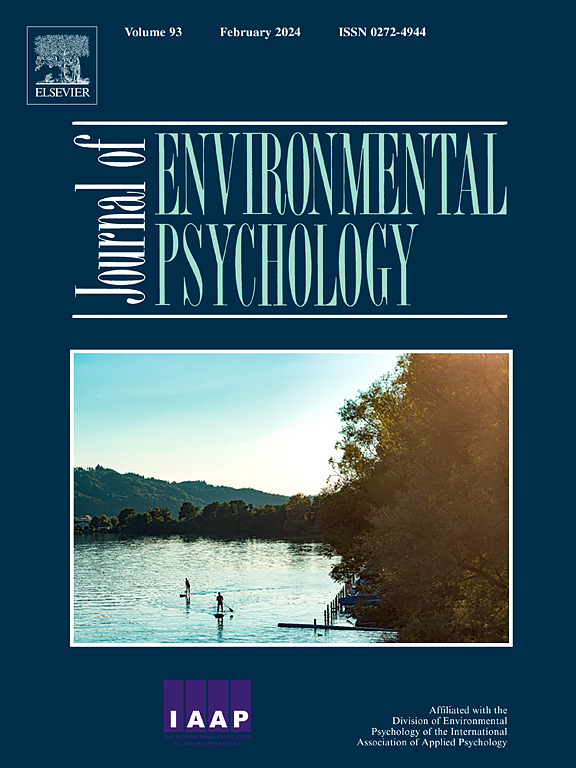青少年脑认知发展(ABCD)研究中绿地暴露、脑和心理健康与认知的关系
IF 6.1
1区 心理学
Q1 ENVIRONMENTAL STUDIES
引用次数: 0
摘要
城市绿地暴露对心理健康和认知的影响然而,儿童对环境影响特别敏感,其潜在的神经机制尚不清楚。方法:本横断面研究分析了ABCD研究的基线数据,涉及美国21个地区的9-10岁儿童。GSE包括归一化植被指数和树冠等9个指标。采用MRI评估脑结构(BS)和脑白质微结构(WMM)。进行群体因子分析(GFA)以确定GSE与大脑指标之间的联系模式。心理健康通过内化和外化t得分进行评估,而认知则通过流体智力和结晶智力得分进行评估。结果纳入BS数据8430例,WMM数据8161例。BSGFA 1与较高的GSE相关,与表面积、皮质体积、皮质下体积和大多数皮质厚度指标呈正相关。它预测较低的内化(β = - 0.08, p <;0.001, 95% CI, - 0.13至- 0.04)和外化问题(β = - 0.10, p <;0.001, 95% CI, - 0.15至- 0.06),更高的结晶智力(β = 0.12, p <;0.001, 95% CI, 0.08 ~ 0.17)。WGFA 1与较大的GSE相关,与分数各向异性正相关,与平均扩散率负相关。它预测较低的外化问题(β = - 0.04, p = 0.01, 95% CI, - 0.06至- 0.01)和改善的流体(β = 0.14, p <;0.001, 95% CI, 0.11 ~ 0.17)和结晶智力(β = 0.04, p = 0.01, 95% CI, 0.01 ~ 0.06)。森林相关WGFA 2与分数各向异性和流体智力呈负相关(β = - 0.10, p <;0.001, 95% CI, - 0.15 ~ - 0.06)。结论本研究强调了城市GSE对儿童大脑发育、心理健康和认知功能的益处。值得注意的是,与城市绿地相比,森林相关的GSE表现出明显的效应,这表明绿地的类型和特征至关重要。未来的研究应探讨不同类型的GSE的长期影响,为支持心理健康和认知的城市设计提供信息。本文章由计算机程序翻译,如有差异,请以英文原文为准。
Associations Among green space exposure, brain, and mental health and cognition in the Adolescent brain cognitive development (ABCD) study
Background
Urban green space exposure (GSE) benefits mental health and cognition; however, the underlying neural mechanisms in children, a population especially sensitive to environmental influences, remain unclear.
Methods
This cross-sectional study analyzed baseline data from the ABCD study, involving 9-10-year-old children across 21 U.S. sites. GSE included nine indicators, such as Normalized Difference Vegetation Index and tree canopy. Brain structure (BS) and white matter microstructure (WMM) were assessed using MRI. Group Factor Analysis (GFA) was conducted to identify patterns linking GSE with brain metrics. Mental health was evaluated via internalizing and externalizing T-scores, while cognition was assessed using fluid and crystallized intelligence scores.
Results
The study included 8430 participants with BS data and 8161 with WMM data. BSGFA 1, associated with higher GSE, positively correlated with surface area, cortical volume, subcortical volume, and most cortical thickness indicators. It predicted lower internalizing (β = −0.08, p < 0.001, 95 % CI, −0.13 to −0.04) and externalizing problems (β = −0.10, p < 0.001, 95 % CI, −0.15 to −0.06), and greater crystallized intelligence (β = 0.12, p < 0.001, 95 % CI, 0.08 to 0.17). WGFA 1, linked to greater GSE, was positively correlated with fractional anisotropy and negatively with mean diffusivity. It predicted lower externalizing problems (β = −0.04, p = 0.01, 95 % CI, −0.06 to −0.01) and improved fluid (β = 0.14, p < 0.001, 95 % CI, 0.11 to 0.17) and crystallized intelligence (β = 0.04, p = 0.01, 95 % CI, 0.01 to 0.06). Forest-related WGFA 2 was negatively associated with fractional anisotropy and fluid intelligence (β = −0.10, p < 0.001, 95 % CI, −0.15 to −0.06).
Conclusions
This study highlights the benefits of urban GSE on children's brain development, mental health, and cognitive function. Notably, forest-related GSE exhibited distinct effects compared to urban green spaces, suggesting that the type and characteristics of green spaces matter significantly. Future research should investigate the long-term impacts of different types of GSE to inform urban designs supporting mental health and cognition.
求助全文
通过发布文献求助,成功后即可免费获取论文全文。
去求助
来源期刊

Journal of Environmental Psychology
Multiple-
CiteScore
10.60
自引率
8.70%
发文量
140
审稿时长
62 days
期刊介绍:
The Journal of Environmental Psychology is the premier journal in the field, serving individuals in a wide range of disciplines who have an interest in the scientific study of the transactions and interrelationships between people and their surroundings (including built, social, natural and virtual environments, the use and abuse of nature and natural resources, and sustainability-related behavior). The journal publishes internationally contributed empirical studies and reviews of research on these topics that advance new insights. As an important forum for the field, the journal publishes some of the most influential papers in the discipline that reflect the scientific development of environmental psychology. Contributions on theoretical, methodological, and practical aspects of all human-environment interactions are welcome, along with innovative or interdisciplinary approaches that have a psychological emphasis. Research areas include: •Psychological and behavioral aspects of people and nature •Cognitive mapping, spatial cognition and wayfinding •Ecological consequences of human actions •Theories of place, place attachment, and place identity •Environmental risks and hazards: perception, behavior, and management •Perception and evaluation of buildings and natural landscapes •Effects of physical and natural settings on human cognition and health •Theories of proenvironmental behavior, norms, attitudes, and personality •Psychology of sustainability and climate change •Psychological aspects of resource management and crises •Social use of space: crowding, privacy, territoriality, personal space •Design of, and experiences related to, the physical aspects of workplaces, schools, residences, public buildings and public space
 求助内容:
求助内容: 应助结果提醒方式:
应助结果提醒方式:


